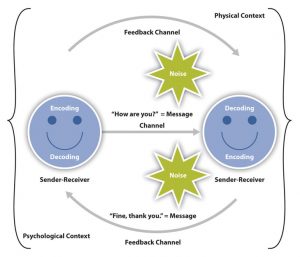2.1.5 The Communication Process
Communication is critically important for any health care provider, as it is the means for obtaining critically important information about a patient’s complaint, their medical history, and their care preferences. Therefore, this Caring Essentials section spends quite a bit of time discussing communication. Let’s start with the basic theory!
The term communication process refers to the exchange of information (a message) between two or more people. For communication to succeed, both parties must be able to exchange information and understand each other. If the flow of information is blocked for some reason or the parties cannot make themselves understood, then communication fails.
The components in communication include:
- The sender (source): the person presenting the information
- The receiver (interpreter): the person who understands the information
- The message (content): the information the sender wants to convey
- The channel (medium): how the message is transmitted
- The feedback (evaluation): the receiver states their understanding of message
Review the following diagram of the communication process carefully. Can you find all of the components from the list above?

Note the presence of noise in the diagram above. Noise refers to anything that can distract from a message being successfully decoded–from standing in a loud construction site (physical context), to simply being distracted (psychological context).
Media Attributions
- The interaction model of communication © University of Minnesota is licensed under a CC BY-NC-SA (Attribution NonCommercial ShareAlike) license

